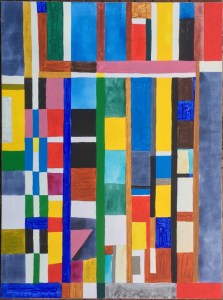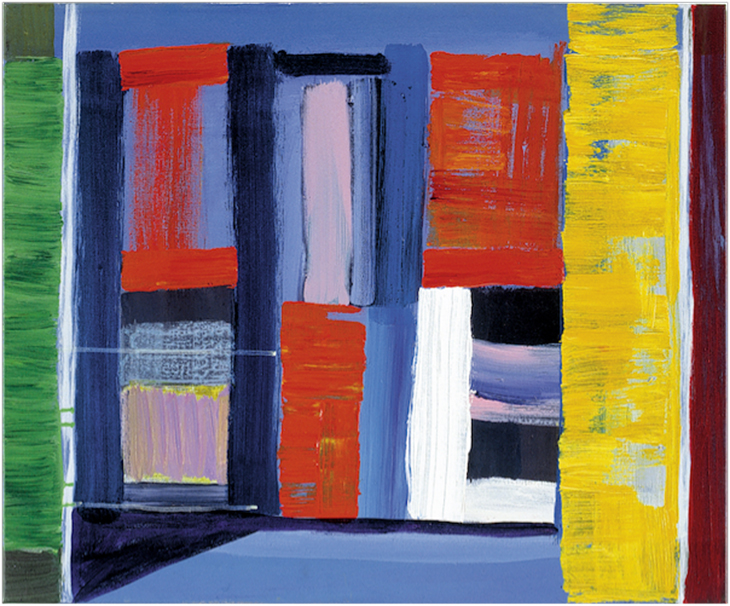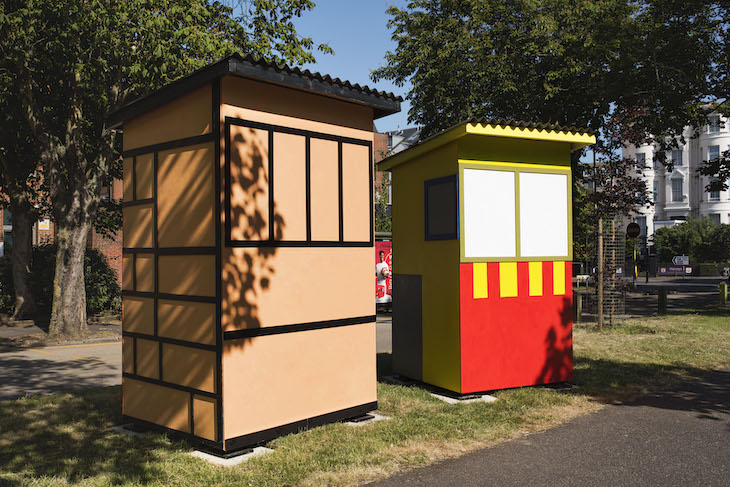I first met Atta Kwami in Kumasi, southern Ghana, in 1994. I had a spell of sabbatical leave from teaching at the School of Oriental and African Studies (SOAS) in London, and I had heard interesting things about painting in Kumasi – especially regarding the relationship between university artists, such as Atta, and the inner-city signboard painters. I had previously met Atta’s colleague and former teacher, the painter Ato Delaquis; Sarah Brown, one of my students at the time (now principal keeper at Leeds Art Gallery) had written her BA dissertation about the two groups of artists. Now I wanted to see for myself. Atta introduced me to Almighty God Artworks, one of the city’s leading sign-painting studios and I soon met others, including Elvis Presley, responsible for the Mickey Mouse figures adorning the Picasso bar in Kumasi. We travelled together through south-eastern Ghana looking at works of art of all shapes, sizes and materials.

Kokomlemle (2014), Atta Kwami. Courtesy Beardsmore Gallery
Atta was interested in everything: he resisted all the party lines of the art world at the time. Perhaps this is why we worked so well together. My work has involved, among other things, in exploring continuities and discontinuities in Africa from one artist or tradition to another, through time. Atta’s painting and printmaking, his kiosks and archways, worked in a similar way. He spoke about carrying a visual memory with him, a memory that included his mother, Grace Salome Kwami, also an artist, his time in Tamale in northern Ghana – as a child, and for a spell after graduating from university in 1974 – and his experience of the very different visual environments of southern Ghana. With regard to a painting I particularly admired, entitled Fiase [shop fronts] (2001), he told me how his work was sometimes like seeing the bright Ghanaian urban environment as if through the crack between a door and its doorpost. His art enlivened the places in which it was exhibited, introducing the unique visual environments of Ghana to the wider world.

Fiase (shop fronts) (2001), Atta Kwami
I had the privilege of being one of Atta’s supervisors for his Open University PhD, published in 2013 as Kumasi Realism – a term, he wrote, that describes ‘a body of work that draws upon photography, advertising, graphic design, European art history, Ghanaian history and culture, and current social problems’ and that includes the city sign-painters as much as the university artists: the interaction between the two was a crucial element of his thesis. His research and his ideas flowed into words with such ease that there really was nothing for me to do other than listen, read, discuss, and learn.
He was expansive about his own work, and its influences. He wrote about watching his mother, as he was about to start primary school with his twin sister, ‘construct boxes in which to carry our rulers, books, pencils, slate and chalk […] on top of each box, she glued a colour print of a tree in a landscape with a blue sky. The visceral impact of those boxes and how they were made is embedded in my memory’. He found this same sense of the extraordinary in everyday life everywhere – ‘kiosks, commercial (sign) painting, woven textiles, Ghanaian music, and jazz, all of which allow for serial composition in strips, stripes, grids.’ But he did not include himself within ‘Kumasi Realism’. He wrote about how his work was ‘described conventionally as “abstract”’ – but, he continued, ‘given that there is a very precise, knowable set of resources at the back of it, I would describe it rather as schematic: not like a map, but like a reaction to or interpretation of a map […] the outcome of a series of engagements between practices, forms and visual environments that are specific to me in Ghana.’

Dusiadu (EveryTown) (2020), Atta Kwami, installation view at the Folkestone Triennial in 2021.
Atta was at home in Ghana, but he was equally at home in the international art worlds of Europe, the United States, and elsewhere. For nearly two decades from 1986 he taught at the university of Kumasi, but in due course he was able to leave academic life there, supported instead by the success of his art. From the 1990s he divided his time between Kumasi and Loughborough where his wife, Pamela Clarkson, also a printmaker, had a house. Atta spoke at international conferences; his work can be seen in the collections of many museums through many countries; and he was successful in winning grants and commissions, most recently the prestigious Maria Lassnig award. At the time of his death, he was working on an architectural installation for the Serpentine in London – a public art commission that accompanied the Lassnig prize. His death at the age of 65 is a tragedy for art. His burial in the Loughborough countryside was an event of peaceful magnificence.
John Picton is emeritus professor of African art, SOAS University of London.

‘He found the extraordinary everywhere’ – a tribute to Atta Kwami (1956–2021)
Photo: © Modern Painters, New Decorators; courtesy Serpentine
Share
I first met Atta Kwami in Kumasi, southern Ghana, in 1994. I had a spell of sabbatical leave from teaching at the School of Oriental and African Studies (SOAS) in London, and I had heard interesting things about painting in Kumasi – especially regarding the relationship between university artists, such as Atta, and the inner-city signboard painters. I had previously met Atta’s colleague and former teacher, the painter Ato Delaquis; Sarah Brown, one of my students at the time (now principal keeper at Leeds Art Gallery) had written her BA dissertation about the two groups of artists. Now I wanted to see for myself. Atta introduced me to Almighty God Artworks, one of the city’s leading sign-painting studios and I soon met others, including Elvis Presley, responsible for the Mickey Mouse figures adorning the Picasso bar in Kumasi. We travelled together through south-eastern Ghana looking at works of art of all shapes, sizes and materials.
Kokomlemle (2014), Atta Kwami. Courtesy Beardsmore Gallery
Atta was interested in everything: he resisted all the party lines of the art world at the time. Perhaps this is why we worked so well together. My work has involved, among other things, in exploring continuities and discontinuities in Africa from one artist or tradition to another, through time. Atta’s painting and printmaking, his kiosks and archways, worked in a similar way. He spoke about carrying a visual memory with him, a memory that included his mother, Grace Salome Kwami, also an artist, his time in Tamale in northern Ghana – as a child, and for a spell after graduating from university in 1974 – and his experience of the very different visual environments of southern Ghana. With regard to a painting I particularly admired, entitled Fiase [shop fronts] (2001), he told me how his work was sometimes like seeing the bright Ghanaian urban environment as if through the crack between a door and its doorpost. His art enlivened the places in which it was exhibited, introducing the unique visual environments of Ghana to the wider world.
Fiase (shop fronts) (2001), Atta Kwami
I had the privilege of being one of Atta’s supervisors for his Open University PhD, published in 2013 as Kumasi Realism – a term, he wrote, that describes ‘a body of work that draws upon photography, advertising, graphic design, European art history, Ghanaian history and culture, and current social problems’ and that includes the city sign-painters as much as the university artists: the interaction between the two was a crucial element of his thesis. His research and his ideas flowed into words with such ease that there really was nothing for me to do other than listen, read, discuss, and learn.
He was expansive about his own work, and its influences. He wrote about watching his mother, as he was about to start primary school with his twin sister, ‘construct boxes in which to carry our rulers, books, pencils, slate and chalk […] on top of each box, she glued a colour print of a tree in a landscape with a blue sky. The visceral impact of those boxes and how they were made is embedded in my memory’. He found this same sense of the extraordinary in everyday life everywhere – ‘kiosks, commercial (sign) painting, woven textiles, Ghanaian music, and jazz, all of which allow for serial composition in strips, stripes, grids.’ But he did not include himself within ‘Kumasi Realism’. He wrote about how his work was ‘described conventionally as “abstract”’ – but, he continued, ‘given that there is a very precise, knowable set of resources at the back of it, I would describe it rather as schematic: not like a map, but like a reaction to or interpretation of a map […] the outcome of a series of engagements between practices, forms and visual environments that are specific to me in Ghana.’
Dusiadu (EveryTown) (2020), Atta Kwami, installation view at the Folkestone Triennial in 2021.
Atta was at home in Ghana, but he was equally at home in the international art worlds of Europe, the United States, and elsewhere. For nearly two decades from 1986 he taught at the university of Kumasi, but in due course he was able to leave academic life there, supported instead by the success of his art. From the 1990s he divided his time between Kumasi and Loughborough where his wife, Pamela Clarkson, also a printmaker, had a house. Atta spoke at international conferences; his work can be seen in the collections of many museums through many countries; and he was successful in winning grants and commissions, most recently the prestigious Maria Lassnig award. At the time of his death, he was working on an architectural installation for the Serpentine in London – a public art commission that accompanied the Lassnig prize. His death at the age of 65 is a tragedy for art. His burial in the Loughborough countryside was an event of peaceful magnificence.
John Picton is emeritus professor of African art, SOAS University of London.
Unlimited access from just $16 every 3 months
Subscribe to get unlimited and exclusive access to the top art stories, interviews and exhibition reviews.
Share
Recommended for you
Exploring Ghana’s growing art scene
Public funding for the arts in Ghana is practically non-existent, but a thriving network of artists and arts professionals is emerging
Ibrahim Mahama
Artist and founder of the Savannah Centre for Contemporary Art, Tamale
‘The dungeons are decorated with wreaths left by slaves’ descendants’
Four centuries after the first English slave ship arrived in Jamestown, Virginia, the president of Ghana is urging members of the African diaspora to discover their roots